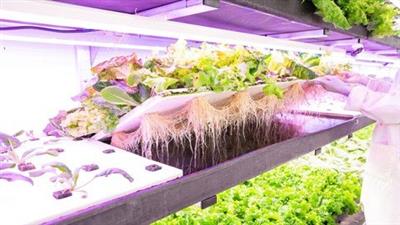M
0

Hydroponics Design Farming And Gardening
Last updated 12/2021
MP4 | Video: h264, 1280x720 | Audio: AAC, 44.1 KHz
Language: English | Size: 3.47 GB | Duration: 2h 38m
How does hydroponic work, Hydroponic systems, Nutrient solutions, Growing support materials, hydroponic farming steps
Last updated 12/2021
MP4 | Video: h264, 1280x720 | Audio: AAC, 44.1 KHz
Language: English | Size: 3.47 GB | Duration: 2h 38m
How does hydroponic work, Hydroponic systems, Nutrient solutions, Growing support materials, hydroponic farming steps
What you'll learn
The history of hydroponics
How does hydroponics work
Components of a hydroponics system
Six types of hydroponics systems
Substrates ( growing support materials)
Nutrient solution of hydroponics
Best hydroponics plants ( vegetable, herds or fruits)
How to get started with hydroponics farming in five steps
Ways to use hydroponics
Hydroponics versus soil
Misconceptions of hydroponics farming
Tips to success in hydroponics growing
Best hydroponics gardening tips and tricks
Requirements
No requirement
Description
The world economy has change drastically in terms of population and faring mechanisms, this has contributed to a lot of creative concept that aid agriculture so that there will be abundance of food and vegetable to feed the growing population. One farming tactics that has aid in the production of food and vegetables is called hydroponics, this is a very great type of horticulture and a subset of hydroculture which clearly involves the growing of plants and vegetables without soil. There is something we all must understand that by clearly using nutrients solutions in an aqueous solvents, plants may grow their roots which is expose to nutrients liquid, which its root might physically be supported by some inert medium such as gravel, coconut coir and other essential substrates to ensure that the crop grow well to yield better for the farmer or gardener. The great news here is that there are so many plants and vegetables that can be grow with this type and method of farming.Hydroponic farming is far better in this current times than never before because current farming on land is very difficult because there are shortage of lands and to get land now even is very expensive with so many farming land litigation a cross the globe. There are cheap farming methods under this and there are also expensive farming methods under this when one is doing it commercially or for individual usage or consumption. Te good news is that so any plants and vegetables or crops can be grown under this horticulture farming tactics such as tomatoes, peppers, cucumbers and lettuce etc. Farmers must be aware that some nutrients used in hydroponics systems can come from, chemical fertilizers, fish excretions and duck manure. Hydroponics farming requires you to be more conscious and seek information from a experts if you lack information or you are a new starter.hydroponics farming need time and careful attention towards the produce of the farms and make sure that always the water content is good and meet the required standard for the farm and plants or crops.
Overview
Section 1: Introduction
Lecture 1 Introduction
Lecture 2 What is hydroponics
Lecture 3 The history of hydroponics
Lecture 4 How does hydroponics work
Lecture 5 Advantages of hydroponics
Lecture 6 Component of a hydroponics system
Section 2: Six Types Of Hydroponics Systems
Lecture 7 Deep water systems
Lecture 8 Wick systems
Lecture 9 Nutrient film techniques system
Lecture 10 Ebb and flow system
Lecture 11 Drip systems
Lecture 12 Aeroponics
Section 3: Substrates(Growing Support Materials)
Lecture 13 Expanded clay aggregate and growstones
Lecture 14 Coconut coir
Lecture 15 Rice husks, pertile and vermiculite
Lecture 16 Sand, gravel and wood fiber
Lecture 17 Sheep pool and rock wool
Lecture 18 Brick shard and polystyrene packing peanuts
Section 4: Nutrient Solution
Lecture 19 Inorganic hydroponic solution
Lecture 20 Organic hydroponic solution
Lecture 21 Additives
Lecture 22 Tools
Lecture 23 Mixing solution
Section 5: Best Hydroponic plant (Vegetables Herbs Or Fruits)
Lecture 24 Lettuce, strawberries and cucumbers
Lecture 25 Spinach, beans and bell pepper
Lecture 26 Chives, blueberries and tomatoes
Lecture 27 Kate, basil and grapes
Lecture 28 Celery, sage and cantaloupe
Section 6: How To Get Started With Hydroponics Farming In 5 Steps
Lecture 29 Get to know your market
Lecture 30 Choose the right growing system for your needs
Lecture 31 Select a distribution model
Lecture 32 Validate the feasibility of your model
Lecture 33 Plant your first seeds
Section 7: Ways To Use Hydroponics
Lecture 34 Big warehouse for hydroponic growing
Lecture 35 Modular container farms
Lecture 36 Do it yourself versus turn - key
Lecture 37 Grow towers
Section 8: Hydroponics Versus Soil
Lecture 38 Carbon sequestration
Lecture 39 Speed
Lecture 40 Climate
Lecture 41 Soil condition
Lecture 42 Land
Lecture 43 Produce varieties
Section 9: Misconceptions Of Hydroponic Farming
Lecture 44 You can only grow lettuce in a hydroponic farm
Lecture 45 IT requires specialized education
Lecture 46 Hydroponic plants taste "funny"
Section 10: Four Tips To Success In Hydroponic growing
Lecture 47 Ensuring water quality
Lecture 48 Introduce a fertigation system
Lecture 49 Choose the right growing median
Lecture 50 Clean the system regularly
Section 11: Best Hydroponics Gardening Tips And Tricks
Lecture 51 Introduction
Lecture 52 Having a plan
Lecture 53 Feeding nutrient
Lecture 54 Root Health
Lecture 55 Adequate lighting
Lecture 56 Controlling the temperature
Lecture 57 Photo period manipulation
Lecture 58 The right equipment & tools
students, farmers, gardeners, horticulture experts, agricultural managers, agricultural workers, backyard farmers, ministries of agricultural, vegetable growers, farm owners, managers, directors, customers of farm produce, vegetarians, everybody etc.

Download link
rapidgator.net:
You must reply in thread to view hidden text.
uploadgig.com:
You must reply in thread to view hidden text.
nitroflare.com:
You must reply in thread to view hidden text.
1dl.net:
You must reply in thread to view hidden text.



